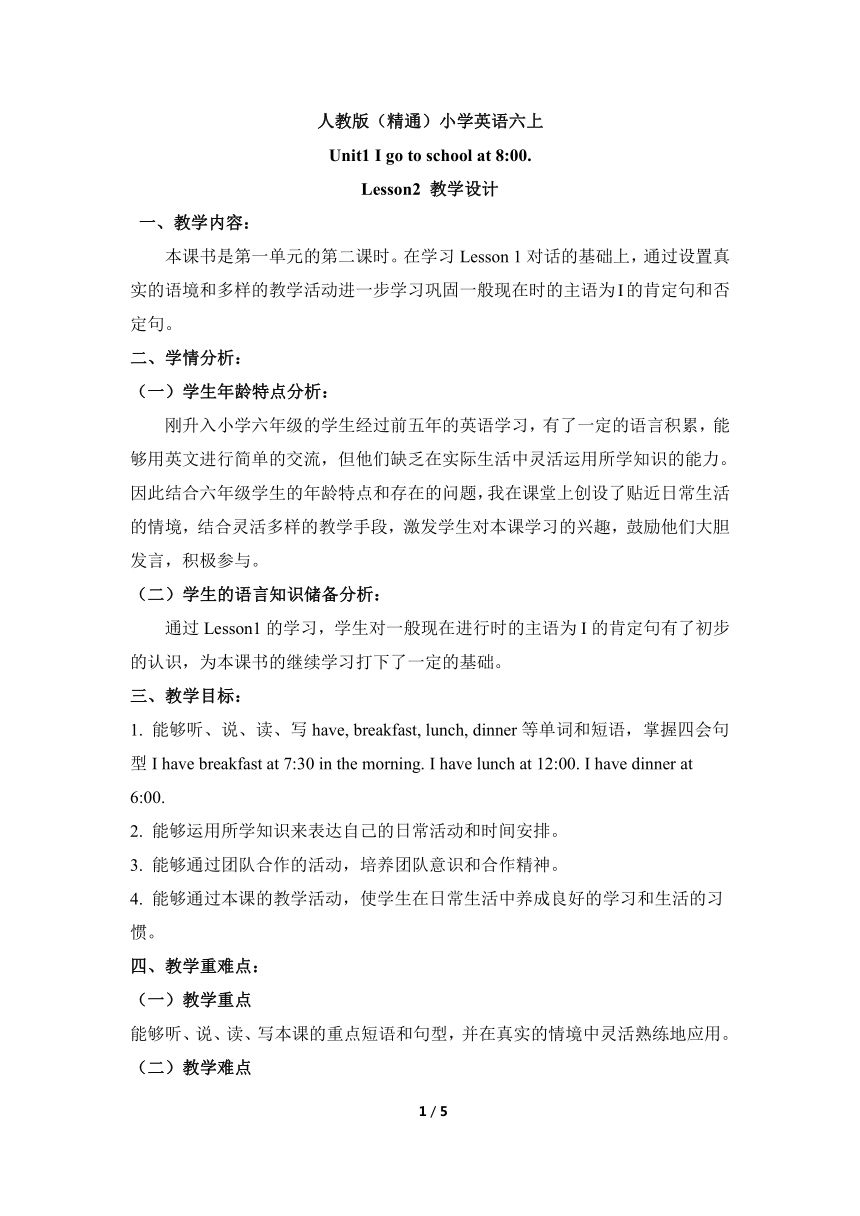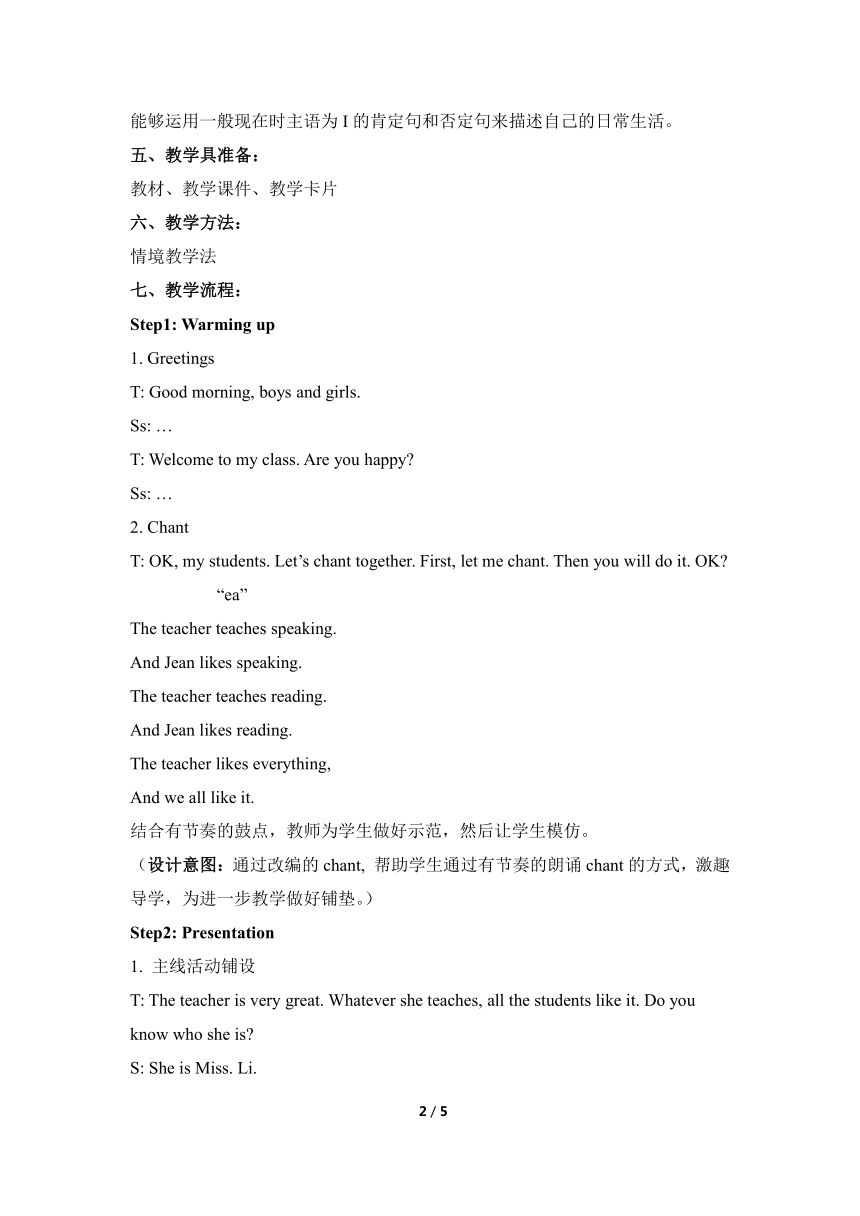Unit 1 I go to school at 800 Lesson 2 教案
文档属性
| 名称 | Unit 1 I go to school at 800 Lesson 2 教案 |  | |
| 格式 | zip | ||
| 文件大小 | 154.7KB | ||
| 资源类型 | 教案 | ||
| 版本资源 | 人教精通版(三年级起点) | ||
| 科目 | 英语 | ||
| 更新时间 | 2019-09-09 17:24:08 | ||
图片预览


文档简介
人教版(精通)小学英语六上
Unit1 I go to school at 8:00.
Lesson2 教学设计
一、教学内容:
本课书是第一单元的第二课时。在学习Lesson 1对话的基础上,通过设置真实的语境和多样的教学活动进一步学习巩固一般现在时的主语为I的肯定句和否定句。
二、学情分析:
(一)学生年龄特点分析:
刚升入小学六年级的学生经过前五年的英语学习,有了一定的语言积累,能够用英文进行简单的交流,但他们缺乏在实际生活中灵活运用所学知识的能力。因此结合六年级学生的年龄特点和存在的问题,我在课堂上创设了贴近日常生活的情境,结合灵活多样的教学手段,激发学生对本课学习的兴趣,鼓励他们大胆发言,积极参与。
(二)学生的语言知识储备分析:
通过Lesson1的学习,学生对一般现在进行时的主语为I的肯定句有了初步的认识,为本课书的继续学习打下了一定的基础。
三、教学目标:
1. 能够听、说、读、写have, breakfast, lunch, dinner等单词和短语,掌握四会句型I have breakfast at 7:30 in the morning. I have lunch at 12:00. I have dinner at 6:00.
2. 能够运用所学知识来表达自己的日常活动和时间安排。
3. 能够通过团队合作的活动,培养团队意识和合作精神。
4. 能够通过本课的教学活动,使学生在日常生活中养成良好的学习和生活的习惯。
四、教学重难点:
(一)教学重点
能够听、说、读、写本课的重点短语和句型,并在真实的情境中灵活熟练地应用。
(二)教学难点
能够运用一般现在时主语为I的肯定句和否定句来描述自己的日常生活。
五、教学具准备:
教材、教学课件、教学卡片
六、教学方法:
情境教学法
七、教学流程:
Step1: Warming up
1. Greetings
T: Good morning, boys and girls.
Ss: …
T: Welcome to my class. Are you happy?
Ss: …
2. Chant
T: OK, my students. Let’s chant together. First, let me chant. Then you will do it. OK?
“ea”
The teacher teaches speaking.
And Jean likes speaking.
The teacher teaches reading.
And Jean likes reading.
The teacher likes everything,
And we all like it.
结合有节奏的鼓点,教师为学生做好示范,然后让学生模仿。
(设计意图:通过改编的chant, 帮助学生通过有节奏的朗诵chant的方式,激趣导学,为进一步教学做好铺垫。)
Step2: Presentation
1. 主线活动铺设
T: The teacher is very great. Whatever she teaches, all the students like it. Do you know who she is?
S: She is Miss. Li.
T: Yes. She is the English teacher of our grade. And now she is on our school TV show. Do you want to know what it is about?
(教学意图:以Miss Li的介绍日常生活的采访为主线,自然导入本课所学内容。并以主持人的问话引出本课的四会和三会短语的学习。)
2. Learn the phrases “have breakfast, have lunch, have dinner, go home.” Students spell and read the phrases.
T: What do you think of Miss Li’s daily life? Tell me her daily activities. For example: get up
(教学意图:通过教师的示范,引导学生学习本课四会和三会的短语,并进行操练,教师将学生所说到的短语打乱顺序贴到黑板上,为下面时间轴的学习做好铺垫。)
3. Learn the sentences: I have breakfast at 6:30 in the morning. I don’t have breakfast at 6:30 am.
T: Look! (教师手指中间的短语) These are Miss Li’s daily activities. But they are in the wrong order. (贴时间轴) Let’s order them according to the time line.
T: Let’s do it in two steps. (出幻灯片-文本的片段)
Step1: read, circle and underline
…
Step2: Let’s make the time line … (投影展示,教师在学案上的时间轴上手写get
up,然后问what time? 学生答:6:00am)
…
(教学意图:分两步对Miss Li的日常生活进行排序,第一步,让学生充分阅读自创文本,通过圈画Miss Li的日常活动和日常活动的相应时间,再认本课的重点短语;第二步,通过在学案的时间轴上标注Miss Li的日常活动和时间,让学生初步运用本课所学的短语。)
T: Let’s act as Miss Li. OK? Now I’m Miss Li. (拿出get up贴到轴上,然后说:
I get up at 6:00 in the morning.) Understand?
…
(教学意图:通过扮演Miss Li对时间轴进行正确排序,来学习本课的重点句型。)
4. Read the text.
T: Good job! Now they are in the right order. Let’s open the book and read it again. Students open the books and read.
(教学意图:通过读课文,为学生的初步运用做好铺垫)
Step3: Practice
1. Do a survey in groups.
Step1:Let’s do a survey in groups.
Step2: Let’s draw a conclusion. (拿一个学生的过来,放投影仪下) I will show you how to make a conclusion. Look at this section. What’s the earliest time? What’s the latest time?
S: …
T: S1, can you draw a conclusion?
S1: We get up between … and …
T: OK. Let’s do it in groups again.
(教学意图:通过层层递进的小组合作,让学生操练本课的重点句型和短语,并感知活动的区间,为下面和Miss Li的日常生活对比奠定基础。)
2. Compare the students’ and Miss Li’s daily life.
T: The group leader tell me your conclusion. I will make notes on the blackboard.
(教学意图:通过学生自己和Miss Li的日常生活对比来巩固和操练本课的短语和句型。)
Step4: Production
1. Make a new schedule for yourself.
T: So make a new schedule for yourself. Here are some advice:
1) Do meaningful (有意义的) activities.
2) Make good use of your time.
3) Learn & relax (放松).
4) Don’t forget to do sports.
Ss: …
2. Give some advice to Miss Li.
(教学意图:通过对比Miss Li的日常生活,引导学生微调自己的日常生活作息
时间,引导学生制定一个健康有意思的适合自己的个人日常生活计划,在展示中鼓励学生积极表达,勇于开口,同时反馈学生对所学知识的掌握情况。)
Step5: Homework
Make a short passage about your new schedule.
(教学意图:通过描述自己的日常生活,巩固本课所学的内容,有效实现课堂知识的拓展延伸。)
板书设计
(设计意图:通过板书设计,突出目标语句和短语。)
5 / 5
Unit1 I go to school at 8:00.
Lesson2 教学设计
一、教学内容:
本课书是第一单元的第二课时。在学习Lesson 1对话的基础上,通过设置真实的语境和多样的教学活动进一步学习巩固一般现在时的主语为I的肯定句和否定句。
二、学情分析:
(一)学生年龄特点分析:
刚升入小学六年级的学生经过前五年的英语学习,有了一定的语言积累,能够用英文进行简单的交流,但他们缺乏在实际生活中灵活运用所学知识的能力。因此结合六年级学生的年龄特点和存在的问题,我在课堂上创设了贴近日常生活的情境,结合灵活多样的教学手段,激发学生对本课学习的兴趣,鼓励他们大胆发言,积极参与。
(二)学生的语言知识储备分析:
通过Lesson1的学习,学生对一般现在进行时的主语为I的肯定句有了初步的认识,为本课书的继续学习打下了一定的基础。
三、教学目标:
1. 能够听、说、读、写have, breakfast, lunch, dinner等单词和短语,掌握四会句型I have breakfast at 7:30 in the morning. I have lunch at 12:00. I have dinner at 6:00.
2. 能够运用所学知识来表达自己的日常活动和时间安排。
3. 能够通过团队合作的活动,培养团队意识和合作精神。
4. 能够通过本课的教学活动,使学生在日常生活中养成良好的学习和生活的习惯。
四、教学重难点:
(一)教学重点
能够听、说、读、写本课的重点短语和句型,并在真实的情境中灵活熟练地应用。
(二)教学难点
能够运用一般现在时主语为I的肯定句和否定句来描述自己的日常生活。
五、教学具准备:
教材、教学课件、教学卡片
六、教学方法:
情境教学法
七、教学流程:
Step1: Warming up
1. Greetings
T: Good morning, boys and girls.
Ss: …
T: Welcome to my class. Are you happy?
Ss: …
2. Chant
T: OK, my students. Let’s chant together. First, let me chant. Then you will do it. OK?
“ea”
The teacher teaches speaking.
And Jean likes speaking.
The teacher teaches reading.
And Jean likes reading.
The teacher likes everything,
And we all like it.
结合有节奏的鼓点,教师为学生做好示范,然后让学生模仿。
(设计意图:通过改编的chant, 帮助学生通过有节奏的朗诵chant的方式,激趣导学,为进一步教学做好铺垫。)
Step2: Presentation
1. 主线活动铺设
T: The teacher is very great. Whatever she teaches, all the students like it. Do you know who she is?
S: She is Miss. Li.
T: Yes. She is the English teacher of our grade. And now she is on our school TV show. Do you want to know what it is about?
(教学意图:以Miss Li的介绍日常生活的采访为主线,自然导入本课所学内容。并以主持人的问话引出本课的四会和三会短语的学习。)
2. Learn the phrases “have breakfast, have lunch, have dinner, go home.” Students spell and read the phrases.
T: What do you think of Miss Li’s daily life? Tell me her daily activities. For example: get up
(教学意图:通过教师的示范,引导学生学习本课四会和三会的短语,并进行操练,教师将学生所说到的短语打乱顺序贴到黑板上,为下面时间轴的学习做好铺垫。)
3. Learn the sentences: I have breakfast at 6:30 in the morning. I don’t have breakfast at 6:30 am.
T: Look! (教师手指中间的短语) These are Miss Li’s daily activities. But they are in the wrong order. (贴时间轴) Let’s order them according to the time line.
T: Let’s do it in two steps. (出幻灯片-文本的片段)
Step1: read, circle and underline
…
Step2: Let’s make the time line … (投影展示,教师在学案上的时间轴上手写get
up,然后问what time? 学生答:6:00am)
…
(教学意图:分两步对Miss Li的日常生活进行排序,第一步,让学生充分阅读自创文本,通过圈画Miss Li的日常活动和日常活动的相应时间,再认本课的重点短语;第二步,通过在学案的时间轴上标注Miss Li的日常活动和时间,让学生初步运用本课所学的短语。)
T: Let’s act as Miss Li. OK? Now I’m Miss Li. (拿出get up贴到轴上,然后说:
I get up at 6:00 in the morning.) Understand?
…
(教学意图:通过扮演Miss Li对时间轴进行正确排序,来学习本课的重点句型。)
4. Read the text.
T: Good job! Now they are in the right order. Let’s open the book and read it again. Students open the books and read.
(教学意图:通过读课文,为学生的初步运用做好铺垫)
Step3: Practice
1. Do a survey in groups.
Step1:Let’s do a survey in groups.
Step2: Let’s draw a conclusion. (拿一个学生的过来,放投影仪下) I will show you how to make a conclusion. Look at this section. What’s the earliest time? What’s the latest time?
S: …
T: S1, can you draw a conclusion?
S1: We get up between … and …
T: OK. Let’s do it in groups again.
(教学意图:通过层层递进的小组合作,让学生操练本课的重点句型和短语,并感知活动的区间,为下面和Miss Li的日常生活对比奠定基础。)
2. Compare the students’ and Miss Li’s daily life.
T: The group leader tell me your conclusion. I will make notes on the blackboard.
(教学意图:通过学生自己和Miss Li的日常生活对比来巩固和操练本课的短语和句型。)
Step4: Production
1. Make a new schedule for yourself.
T: So make a new schedule for yourself. Here are some advice:
1) Do meaningful (有意义的) activities.
2) Make good use of your time.
3) Learn & relax (放松).
4) Don’t forget to do sports.
Ss: …
2. Give some advice to Miss Li.
(教学意图:通过对比Miss Li的日常生活,引导学生微调自己的日常生活作息
时间,引导学生制定一个健康有意思的适合自己的个人日常生活计划,在展示中鼓励学生积极表达,勇于开口,同时反馈学生对所学知识的掌握情况。)
Step5: Homework
Make a short passage about your new schedule.
(教学意图:通过描述自己的日常生活,巩固本课所学的内容,有效实现课堂知识的拓展延伸。)
板书设计
(设计意图:通过板书设计,突出目标语句和短语。)
5 / 5
同课章节目录
- Unit 1 I go to school at 8:00.
- Lesson 1
- Lesson 2
- Lesson 3
- Lesson 4
- Lesson 5
- Lesson 6
- Unit 2 What's your hobby?
- Lesson 7
- Lesson 8
- Lesson 9
- Lesson 10
- Lesson 11
- Lesson 12
- Unit 3 Would you like to come to my birthday party
- Lesson 13
- Lesson 14
- Lesson 15
- Lesson 16
- Lesson 17
- Lesson 18
- Fun Time 1
- Recycle 1
- Recycle 2
- Fun Reading
- Unit 4 January is the first month.
- Lesson 19
- Lesson 20
- Lesson 21
- Lesson 22
- Lesson 23
- Lesson 24
- Unit 5 July is the seventh month.
- Lesson 25
- Lesson 26
- Lesson 27
- Lesson 28
- Lesson 29
- Lesson 30
- Unit 6 There are four seasons in a year.
- Lesson 31
- Lesson 32
- Lesson 33
- Lesson 34
- Lesson 35
- Lesson 36
- Fun Time 2
- Recycle 1
- Recycle 2
- Fun Reading
